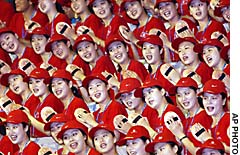Defector: NK Cheerleaders Sent to Gulag
Who recalls the days when South Korea’s faith in reunification bordered on an obession – a religion, perhaps? Nothing was more telling of the North Korean regime’s success at self-popularization in the South than the public swooning over a squad of North Korean cheerleaders, despite all the procrustean, regimented eeriness surrounding them. Let’s look back at that time:
This bustling South Korean port bid an emotional farewell Tuesday to a North Korean cheering squad whose presence at the Asian Games, with all its propaganda trappings, has sparked a mood of reconciliation.
“Urinun hanada (We are one),” “Chuguk Tongil (Unify the fatherland).”
The slogans, which have been heard many times at events involving athletes from the north of the divided peninsula during the two-week Games, were exchanged for the last time as a North Korean ship sailed out.
Some 400 selected Busan citizens, with tears in many of their eyes, waved goodbye to all hands, numbering 360, aboard the Mangyongbong-92 after a 90-minute farewell ceremony.
About 2,000 more people watched from outside the fence as a brass band played “Our wish is unification,” a hymn which has been sung on both sides as they struggled in finding ways to ease tension and reunite.
(Photo cred: Chosun Ilbo)
Journalists, and a few locals, were put off by the extreme control measures the North Koreans exercised over the women.
The women, who are bused to the games from remote accomodation outside the city every day, are kept under such strict security that even journalists assigned to cover them have become disgruntled.
On Saturday, photojournalists laid down their cameras outside a hotel where the cheerleaders were appearing to protest against the lack of access.
North Korean standards of sportsmanship didn’t exactly impress non-Korean observers, either:
The girls gave the cold shoulder to the Japanese and U.S. teams at the opening ceremony. They suddenly became quiet when the two delegations walked in front of them and resumed cheering immediately after they marched off.
– II –
 And is so often the case with North Korea, elaborate facades differ from grim reality. The obvious caution is that this is a report from just one defector (one can presume that the corroborating witnesses are either dead, still in the camp, or too isolated and afraid to speak):
And is so often the case with North Korea, elaborate facades differ from grim reality. The obvious caution is that this is a report from just one defector (one can presume that the corroborating witnesses are either dead, still in the camp, or too isolated and afraid to speak):
Lee Myeong-ho, a former inmate of the Daeheung concentration camp in South Hamgyeong Province who recently escaped to China, said “21 beautiful women” were detained at the camp since the end of last year. “Later I found out that they were the cheerleading team that had gone to South Korea,” he said.
Lee said since inmates are forbidden to talk to one another, he could not find out for sure what mistake they had made, but the rumor was that they had broken their promise to North Korean security services not to disclose what they had seen in South Korea.
Another defector explained the cheerleaders are picked among university students, propaganda squad members and music school students from good families. Before they were sent to South Korea, they had to sign a pledge bearing their 10 fingerprints that says if they are going to an enemy country — Pyongyang’s epithet for the South — they must fight as soldiers of leader Kim Jong-il and never talk about what they have seen or heard in South Korea once they return. They agree to accept punishment if they break the promise.
Lee even identified the camp:
[Daehung], known as one of the worst in North Korea, is located in a mining area high in ragged mountains where there is hardly any vegetation.
I tried, unsuccessfully, to find a satellite photo of Daehung here.
As for the plausibility of the report, I’d note that it’s consistent with Stalinist practice. Stalin was so paranoid about exposure to the outside world that his subjects who had been exposed to “foreign” ideas faced a much higher risk of ending up in the gulag. Ironically, Soviet Koreans were among those on whom such suspicion fell most heavily.
11 Responses
-
Pingback: Occidentalism » Propaganda
Sort of like putting a bunch of birds in quarantine or culling them from the flock. Freedom flu?
The cheers have turned to tears.
I was in Pusan in 2002 and the striking thing for me is how the Korean press and public were affixed on the women, while Western reporters focused on the cage.
It was to be expected. In spite of the restrictions set against these women by their handlers, they had ample opportunity to witness evidence that refutes everything they know. It’s only natural that someone who has seen the light will try to bring news of it existence to those who remain inside the cave.
This kind of thing seems to me a much bigger sign of what the future holds than the “reforms” so many people over the years have touted. When the regime runs out NGOs trying to feed its people and stuff like this, who in their right mind would believe the North has the will to reform?
I’m speechless… these comments from 2006 have proven to be true…when will we ever learn?
How much longer will the US government, the best known outspoken democracy in the world, be silent about the camps?